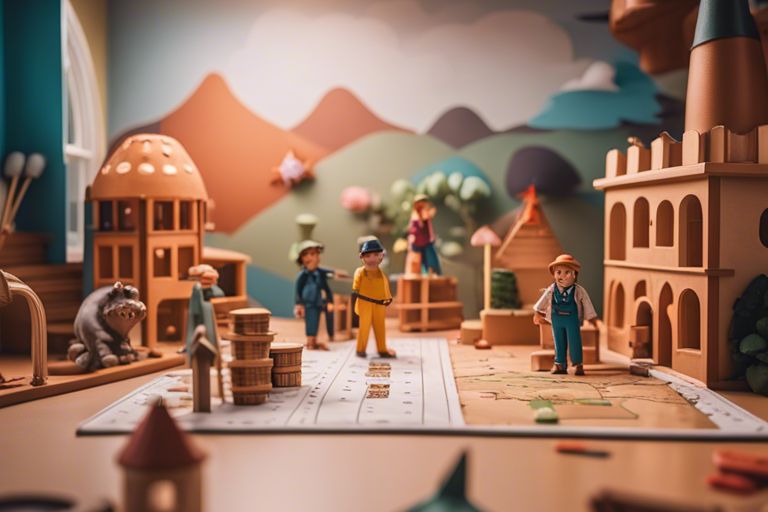There’s no doubt that fostering creativity in your child is necessary for their overall development. As a parent, you play a crucial role in nurturing their imagination and providing them with opportunities to explore their creativity. In this blog post, we will explore eight effective ways to encourage and inspire creativity in your child, helping them to think outside the box and unleash their inner artist.
1. Encourage open-ended play with no rules or guidelines.
2. Provide a variety of art supplies for exploration and creativity.
3. Encourage them to ask questions and explore new ideas.
4. Allow plenty of time for unstructured play and imagination.
5. Read books together and encourage storytelling and imagination.
6. Expose them to new experiences and environments for inspiration.
How-to Tips for Fostering Creativity
Some children are naturally more inclined towards creative activities, while others may need a little nudge in the right direction. As a parent, you play a crucial role in fostering your child’s creativity and helping them develop their imagination.
Provide the Right Tools and Space
While it’s crucial to provide your child with the right tools such as art supplies, musical instruments, or building blocks, it’s equally important to create a conducive environment where they can freely express themselves. Designate a special area in your home where your child can explore and create without any restrictions.
Encourage Curiosity and Exploration
Creativity thrives on curiosity and exploration. Encourage your child to ask questions, make observations, and try new things. Take them on nature walks, visit museums, or engage in hands-on activities that spark their interest. Curiosity is the fuel that drives creativity, so nurture it in your child.
Tools such as books, puzzles, science kits, and art materials can stimulate your child’s curiosity and encourage them to explore different ideas and concepts. By providing these resources, you are giving your child the opportunity to learn and grow creatively.
Knowing when to step back and let your child take the lead is also crucial in fostering their creativity. By giving them the freedom to explore and experiment, you are nurturing their ability to think outside the box and come up with innovative ideas.
Factors That Influence Creative Growth
Clearly, there are several key factors that influence the creative growth of children. By understanding these factors, parents can better foster creativity in their children and help them reach their full potential.
- The Role of Play in Creative Development
- Impact of Restrictive versus Open-Ended Activities
The Role of Play in Creative Development
To nurture creativity in children, play is imperative. Play allows children to explore, experiment, and imagine freely. It helps them develop critical thinking skills, problem-solving abilities, and the confidence to think outside the box. Encouraging unstructured playtime can greatly enhance a child’s creative development.
Impact of Restrictive versus Open-Ended Activities
To stimulate creativity in children, it is important to provide a balance of both restrictive and open-ended activities. While restrictive activities like puzzles and coloring books can help develop focus and fine motor skills, open-ended activities such as building blocks and art projects encourage imagination and innovation. Balancing these activities can help children develop a well-rounded creative skill set.
Growth in creativity can be greatly influenced by the types of activities children engage in. While restrictive activities have their benefits, allowing children the freedom to explore and create through open-ended activities can significantly enhance their creative potential. By providing a mix of both types of activities, parents can support their child’s creative growth and cultivate a lifelong love for imaginative thinking.
Practical Strategies to Spark Imagination
Incorporating Art and Music
To foster creativity in your child, you can introduce them to various forms of art and music. You can encourage them to draw, paint, or make crafts, providing them with the tools and space to express themselves. Exposing them to different genres of music and encouraging them to sing, dance, or even learn to play a musical instrument can also help stimulate their imagination and creativity.
Cultivating Storytelling and Role Play
Even though storytelling and role play may seem like simple activities, they play a crucial role in nurturing your child’s imagination. Encourage your child to create their own stories, either through writing, drawing, or verbal storytelling. Role-playing allows them to step into different characters and scenarios, helping them explore different perspectives and expand their creative thinking skills.
Imagination plays a significant role in shaping a child’s outlook towards the world. By incorporating art and music, as well as storytelling and role play activities, you are providing them with a platform to unleash their creativity, think outside the box, and develop vital skills that will benefit them throughout their lives.

Nurturing a Creative Environment at Home
Setting Up a Creativity-Friendly Home
Not only should you provide your child with the right tools and materials for creative activities, but also consider how you can organize their space to encourage exploration and imagination. Designate a specific area for art supplies and projects, keeping everything easily accessible so your child can probe creativity whenever inspiration strikes.
Embracing Mess and Mistakes
Little artists need room to experiment, make mistakes, and get messy in order to truly unleash their creativity. Encourage your child to explore without worrying about perfection. Create a space where they can paint, build, or craft freely, knowing that it’s okay to make a mess and learn from their errors along the way.
Nurturing a creative environment at home involves providing the right resources, space, and mindset for your child to explore their imagination freely. By setting up a creativity-friendly home and embracing mess and mistakes, you can foster a love for art and innovation in your child that will last a lifetime.
Encouraging Creativity in Education
Collaborating With Educators
While parents play a vital role in fostering creativity in their children, collaborating with educators can amplify the impact. By communicating with teachers about your child’s interests, strengths, and areas for growth, you can work together to tailor the learning experience to spark their imagination. Encouraging open dialogue and sharing insights can help educators create a supportive environment that nurtures creativity in the classroom.
Supporting Extracurricular Activities
The support of extracurricular activities outside of the traditional classroom setting can significantly enhance a child’s creativity. Whether it’s joining a robotics club, drama group, art class, or sports team, these activities provide an opportunity for children to explore their passions, collaborate with peers, and think outside the box. Participating in extracurriculars not only reinforces creative thinking but also helps build confidence, resilience, and social skills in children.
Another way to support extracurricular activities is to expose your child to a diverse range of experiences. From music lessons to nature exploration, allowing your child to explore different interests can broaden their perspective, stimulate their imagination, and ignite a lifelong love for learning. By encouraging curiosity and embracing new challenges, you can help your child develop a well-rounded creative mindset that will serve them well in all aspects of their life.
To wrap up
Presently, fostering creativity in your child is crucial for their overall development. By incorporating activities that spark their imagination like encouraging play, providing open-ended materials, exposing them to diverse experiences, setting aside tech-free time, praising their efforts, embracing mistakes, allowing them to take risks, and being a role model of creativity, you can help your child unleash their full creative potential. These simple yet effective ways can nurture creativity in children and set them on a path towards a more innovative and fulfilling future. So, start implementing these strategies today and watch as your child’s imagination soars to new heights.
FAQ
Q: Why is fostering creativity important in children?
A: Fostering creativity in children is crucial as it helps them develop critical thinking skills, problem-solving abilities, and the confidence to think outside the box. It also encourages self-expression and boosts their imagination, which are valuable traits in today’s rapidly changing world.
Q: What are some ways to spark creativity in a child?
A: There are several ways to spark creativity in a child, including providing them with open-ended materials for art projects, encouraging pretend play, exposing them to a variety of experiences and environments, engaging in activities that require problem-solving, and allowing them the freedom to explore and make mistakes.
How can parents support and nurture their child’s creativity?
A: Parents can support and nurture their child’s creativity by providing them with a stimulating environment that includes art supplies, books, and music, encouraging them to pursue their interests and passions, praising their efforts and ideas, and being open to their unique way of thinking. It is necessary to offer opportunities for creative expression and to celebrate their achievements along the way.




